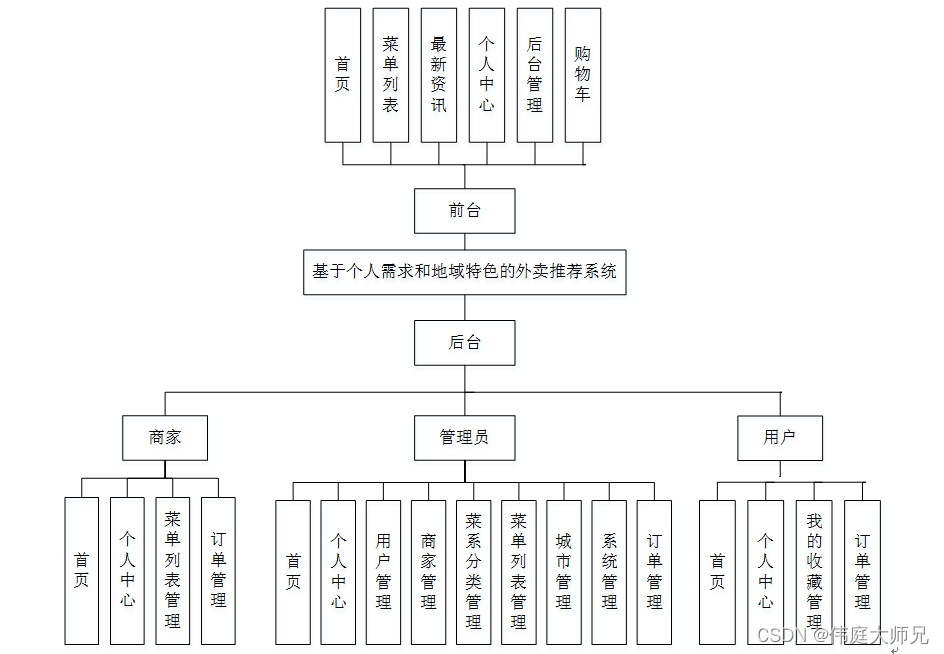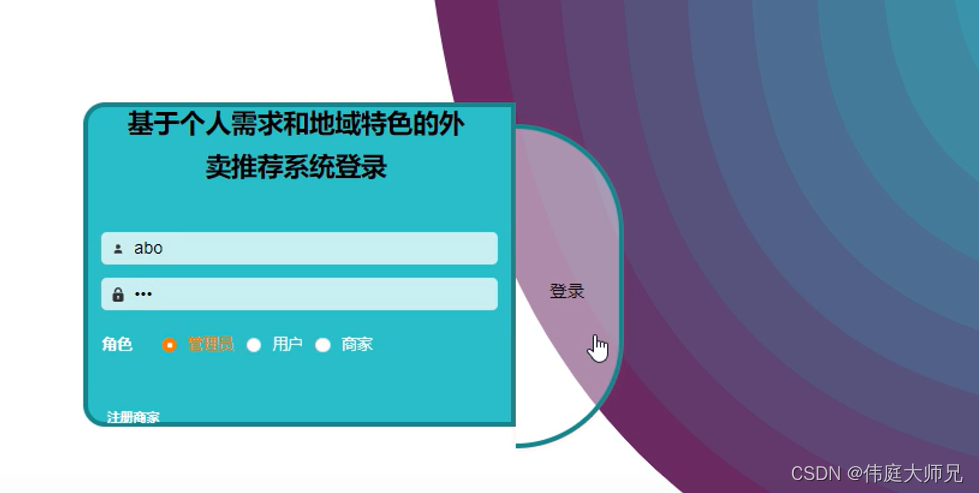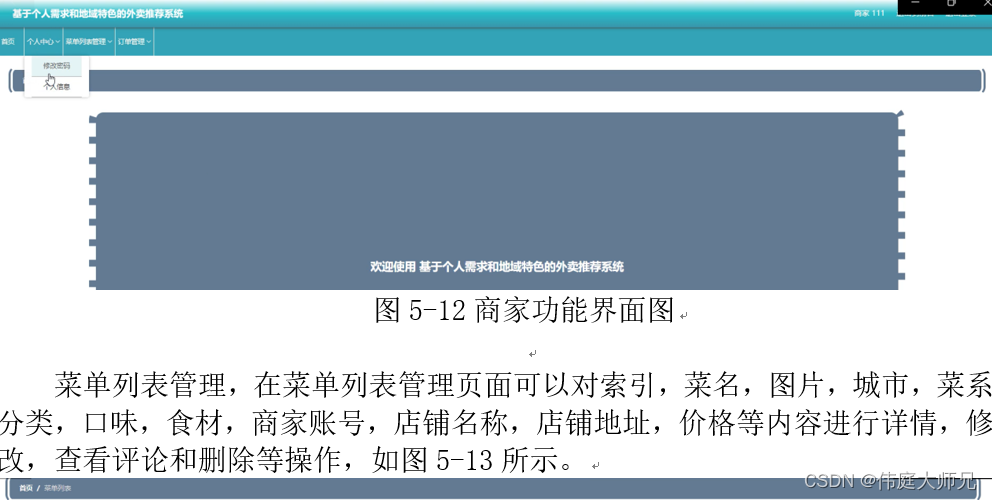外卖推荐系统
目录
博主介绍:✌️大厂码农|毕设布道师,阿里云开发社区乘风者计划专家博主,CSDN平台Java领域优质创作者,专注于大学生项目实战开发、讲解和毕业答疑辅导。✌️
主要项目:小程序、SpringBoot、SSM、Vue、Html、Jsp、Nodejs等设计与开发。
🍅文末获取源码联系🍅
基于SSM+vue的外卖推荐系统的设计与实现
一、前言
首先,论文一开始便是清楚的论述了系统的研究内容。其次,剖析系统需求分析,弄明白“做什么”,分析包括业务分析和业务流程的分析以及用例分析,更进一步明确系统的需求。然后在明白了系统的需求基础上需要进一步地设计系统,主要包罗软件架构模式、整体功能模块、数据库设计。本项目软件架构选择B/S模式,总体功能模块运用自顶向下的分层思想。再然后就是实现系统并进行代码编写实现功能。论文的最后章节总结一下自己完成本论文和开发本项目的心得和总结。通过外卖系推荐统将会使外卖各个方面的工作效率带来实质性的提升。
关键字:外卖推荐系统 B/S模式 软件架构
二、系统设计
系统功能结构如图

三、系统功能设计
1系统功能模块
外卖推荐系统,在系统首页可以查看首页,菜单列表,最新资讯,个人中心,后台管理,购物车等内容,如图5-1所示。

图5-1系统首页界面图
2 管理员功能模块
管理员进入系统,在登录页面根据要求填写用户名和密码,选择角色等信息,点击登录进行登录操作,如图5-4所示。

图5-4管理员登录界面图
3 商家功能模块
商家登录进入外卖推荐系统可以对首页,个人中心,菜单列表管理,订单管理等功能进行相应操作,如图5-12所示。

图5-12商家功能界面图
4 用户功能模块
用户登录进入外卖推荐系统可以对首页,个人中心,我的收藏管理,订单管理等功能进行相应操作,如图5-15所示。

图5-15用户功能界面图
四、数据库设计
商家注册实体图如图4-2所示:

图4-2商家注册实体图
数据库表的设计,如下表:
表4-1:菜系分类
字段名称 |
类型 |
长度 |
字段说明 |
主键 |
默认值 |
id |
bigint |
主键 |
主键 |
||
addtime |
timestamp |
创建时间 |
CURRENT_TIMESTAMP |
||
caixifenlei |
varchar |
200 |
菜系分类 |
五、核心代码
package com.service.impl;
import com.utils.StringUtil;
import com.service.DictionaryService;
import com.utils.ClazzDiff;
import org.springframework.beans.BeanUtils;
import org.springframework.beans.factory.annotation.Autowired;
import org.springframework.stereotype.Service;
import java.lang.reflect.Field;
import java.util.*;
import com.baomidou.mybatisplus.plugins.Page;
import com.baomidou.mybatisplus.service.impl.ServiceImpl;
import org.springframework.transaction.annotation.Transactional;
import com.utils.PageUtils;
import com.utils.Query;
import org.springframework.web.context.ContextLoader;
import javax.servlet.ServletContext;
import javax.servlet.http.HttpServletRequest;
import org.springframework.lang.Nullable;
import org.springframework.util.Assert;
import com.dao.FangwuDao;
import com.entity.FangwuEntity;
import com.service.FangwuService;
import com.entity.view.FangwuView;
@Service("fangwuService")
@Transactional
public class FangwuServiceImpl extends ServiceImpl<FangwuDao, FangwuEntity> implements FangwuService {
@Override
public PageUtils queryPage(Map<String,Object> params) {
Page<FangwuView> page =new Query<FangwuView>(params).getPage();
page.setRecords(baseMapper.selectListView(page,params));
return new PageUtils(page);
}
}
package com.service.impl;
import com.utils.StringUtil;
import com.service.DictionaryService;
import com.utils.ClazzDiff;
import org.springframework.beans.BeanUtils;
import org.springframework.beans.factory.annotation.Autowired;
import org.springframework.stereotype.Service;
import java.lang.reflect.Field;
import java.util.*;
import com.baomidou.mybatisplus.plugins.Page;
import com.baomidou.mybatisplus.service.impl.ServiceImpl;
import org.springframework.transaction.annotation.Transactional;
import com.utils.PageUtils;
import com.utils.Query;
import org.springframework.web.context.ContextLoader;
import javax.servlet.ServletContext;
import javax.servlet.http.HttpServletRequest;
import org.springframework.lang.Nullable;
import org.springframework.util.Assert;
import com.dao.FeiyongDao;
import com.entity.FeiyongEntity;
import com.service.FeiyongService;
import com.entity.view.FeiyongView;
@Service("feiyongService")
@Transactional
public class FeiyongServiceImpl extends ServiceImpl<FeiyongDao, FeiyongEntity> implements FeiyongService {
@Override
public PageUtils queryPage(Map<String,Object> params) {
Page<FeiyongView> page =new Query<FeiyongView>(params).getPage();
page.setRecords(baseMapper.selectListView(page,params));
return new PageUtils(page);
}
}
六、论文参考

七、最新计算机毕设选题推荐
八、源码获取:
大家点赞、收藏、关注、评论啦 、👇🏻获取联系方式在文章末尾👇🏻